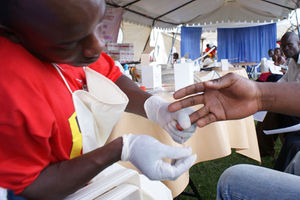-
Editions
-
ePaper

Ensuring a safe, healthy workspace is key
There is a need to provide a first-aid room, especially where work involves certain hazards. PHOTO/healthline.com
What you need to know:
- With a safe and healthy working environment, the ILO Declaration now includes five categories of fundamental principles and rights at work.
A safe and healthy working environment is a fundamental principle and right at work. World Day for Safety and Health at Work is annually observed across the globe on April 28 to raise awareness about creating safe and healthy work environments and promote the prevention of occupational accidents and diseases globally.
In 2003, the International Labour Organization (ILO), a United Nations (UN) agency began to observe this day in order to stress the prevention of accidents and diseases at work globally.
According to the UN agency, employers are responsible for ensuring that the working environment is safe and healthy by promoting and creating a safety and health culture that can help reduce the number of work-related deaths and injuries.
In Uganda, the Ministry of Gender, Labour and Social Development is the lead agency of the Social Development Sector responsible for the promotion of social protection, Gender Equality and Equity, Culture and Decent Work conditions.
The department of Occupational Safety and Health (OSH) in the Directorate of Labour, is the one mandated to ensure the existence of safe and health mechanisms at the work places and work environments.
All round health
A safe and healthy workplace should ensure that it maintains the highest degree of the worker’s physical, mental and social wellbeing.
According to Evelyn Lufafa, a counseling psychologist, mental health is the pivot of human life. However, despite its importance, it is often the least prioritised among health working conditions.
“In such a competitive world today, stress at any workplace is inevitable; deadlines, big projects, and economic hardships are common factors that are contributing to increasing mental health challenges at work,” she remarks.
Despite this trend, there are very few workplaces that have a provision for an in-house counsellor. One has to book an appointment with their insurance provider a couple of days or even weeks later and all the time they are waiting, whatever reason they have for seeing a counselor keeps escalating. By the time of the appointment, it is too late to save a situation or one has lost interest in seeking help.
With a safe and healthy working environment, the ILO Declaration now includes five categories of fundamental principles and rights at work as: freedom of association and the effective recognition of the right to collective bargaining; the elimination of all forms of forced or compulsory labour; the effective abolition of child labour; the elimination of discrimination in respect of employment and occupation; and a safe and healthy working environment.
Training on equipment use
Convention no. 155 article 5 of the ILO declaration states that there should be relationships between the material elements of work and the persons who carry out or supervise the work, and adaptation of machinery, equipment, working time, organisation of work and work processes to the physical and mental capacities of the workers.
Article 16 requires employers to: ensure that, so far as is reasonably practicable, the workplaces, machinery, equipment and processes under their control are safe and without risk to health, the chemical, physical and biological substances and agents under their control are without risk to health when the appropriate measures of protection are taken and provide, where necessary and at no cost to the worker, adequate protective clothing and protective equipment to prevent, so far as is reasonably practicable, risk of accidents or of adverse effects on health.
“Employers shall also be required to provide, where necessary, for measures to deal with emergencies and accidents, including adequate first-aid arrangements,” reads the ILO article.
First aid
Julia Kushemererwa, a human resource consultant, remarks that employees must have access to first-aid requirements. This includes a suitably stocked first-aid box and an appointed person to take charge of first-aid arrangements.
Employers also need to put up notices telling their workers where they can find the first-aiders or appointed persons, the first-aid box. There is also a need to provide a first-aid room, especially where work involves certain hazards, including some of those found in chemical industries and on large construction sites or if required by national legislation.
Provide supervisors
Employers must provide an adequate and appropriate level of supervision for their workers and the supervisors need to understand the employer’s safety and health policy. Supervisors may need training in the specific hazards of the employer’s processes and how the risks are expected to be controlled.
Workers’ representatives should be given adequate information on measures taken by the employer to secure occupational safety and health.
A worker should report to their immediate supervisor any situation which they have reasonable justification to believe presents an imminent and serious danger to their life or health; until the employer have taken remedial action.
Risk assessment
Workplaces do not stay the same. Sooner or later, organisations will bring in new equipment, substances and procedures that could lead to new hazards. It is important to review what is being done on an ongoing basis and frequently conduct workstation inspections
As a way of ensuring safety and health at a workplace, the employer must identify the hazards and control the risks. To do this they must provide safety signs if there is a significant risk that cannot be avoided or controlled in any other way, such as through safe systems of work or engineering controls.
Emergency preparedness
Emergency prevention, preparedness and response arrangements should be established through provision of emergency exits for quick and safe escape, fire assembly points, alarms, fire extinguishers that come in handy in case of emergencies like fire.
Proper Personal Protective Equipment (PPE)
During the Covid-19 pandemic, health workers were at a high risk of catching the disease as hospitals ran short of the protective gears. This meant that their own life was at risk as they saved the lives of other people.
Employees should have access to appropriate PPE, such as hard hats, safety glasses, gloves, masks and earplugs, to help protect them from potential hazards. PPE is also essential for helping employees avoid liability for their injuries.
Proper ventilation systems improve air circulation, reduce odors, and remove harmful substances, ensuring that employees breathe clean and fresh air. This minimises respiratory problems, allergies, and other health issues associated with poor air quality.
Window blinds and curtains offer workplace privacy and lighting management especially for workers who use computers for a long period of time daily.
The Government of Uganda tasked organizations in the Employment Act 2006 and The Equal Opportunity Act 2006 to make workplaces accessible even for persons with disabilities.
Having an accessible workplace is one of the easiest ways to ensure a disability-inclusive workplace for anyone suffering from a health condition or a physical impairment.
High-traffic areas such as corridors and entryways should be wide enough to allow wheelchair users to fit comfortably.
ARTICLE 16
Article 16 requires employers to: ensure that, so far as is reasonably practicable, the workplaces, machinery, equipment and processes under their control are safe and without risk to health, the chemical, physical and biological substances and agents under their control are without risk to health when the appropriate measures of protection are taken and provide, where necessary and at no cost to the worker, adequate protective clothing and protective equipment to prevent, so far as is reasonably practicable, risk of accidents or of adverse effects on health.
“Employers shall also be required to provide, where necessary, for measures to deal with emergencies and accidents, including adequate first-aid arrangements,” reads the ILO article.

